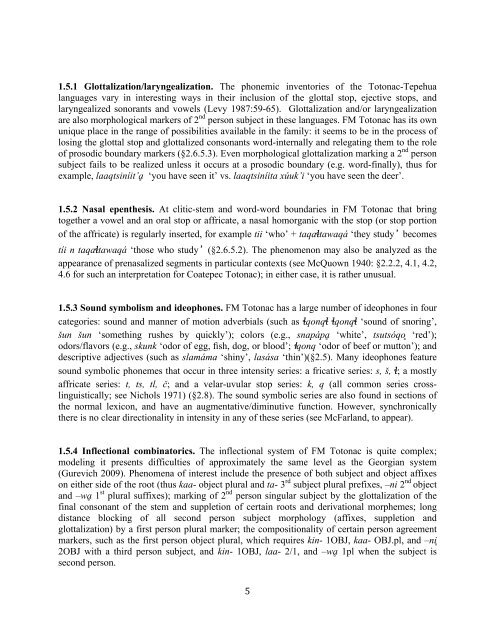The phonology and morphology of Filomeno Mata Totonac
The phonology and morphology of Filomeno Mata Totonac
The phonology and morphology of Filomeno Mata Totonac
You also want an ePaper? Increase the reach of your titles
YUMPU automatically turns print PDFs into web optimized ePapers that Google loves.
1.5.1 Glottalization/laryngealization. <strong>The</strong> phonemic inventories <strong>of</strong> the <strong>Totonac</strong>-Tepehua<br />
languages vary in interesting ways in their inclusion <strong>of</strong> the glottal stop, ejective stops, <strong>and</strong><br />
laryngealized sonorants <strong>and</strong> vowels (Levy 1987:59-65). Glottalization <strong>and</strong>/or laryngealization<br />
are also morphological markers <strong>of</strong> 2 nd person subject in these languages. FM <strong>Totonac</strong> has its own<br />
unique place in the range <strong>of</strong> possibilities available in the family: it seems to be in the process <strong>of</strong><br />
losing the glottal stop <strong>and</strong> glottalized consonants word-internally <strong>and</strong> relegating them to the role<br />
<strong>of</strong> prosodic boundary markers (§2.6.5.3). Even morphological glottalization marking a 2 nd person<br />
subject fails to be realized unless it occurs at a prosodic boundary (e.g. word-finally), thus for<br />
example, laaqtsiníit’! ‘you have seen it’ vs. laaqtsiníita xúuk’i ‘you have seen the deer’.<br />
1.5.2 Nasal epenthesis. At clitic-stem <strong>and</strong> word-word boundaries in FM <strong>Totonac</strong> that bring<br />
together a vowel <strong>and</strong> an oral stop or affricate, a nasal homorganic with the stop (or stop portion<br />
<strong>of</strong> the affricate) is regularly inserted, for example tii ‘who’ + taqa"tawaqá ‘they study! becomes<br />
tíi n taqa"tawaqá ‘those who study! (§2.6.5.2). <strong>The</strong> phenomenon may also be analyzed as the<br />
appearance <strong>of</strong> prenasalized segments in particular contexts (see McQuown 1940: §2.2.2, 4.1, 4.2,<br />
4.6 for such an interpretation for Coatepec <strong>Totonac</strong>); in either case, it is rather unusual.<br />
1.5.3 Sound symbolism <strong>and</strong> ideophones. FM <strong>Totonac</strong> has a large number <strong>of</strong> ideophones in four<br />
categories: sound <strong>and</strong> manner <strong>of</strong> motion adverbials (such as "qonq" "qonq" ‘sound <strong>of</strong> snoring’,<br />
#un #un ‘something rushes by quickly’); colors (e.g., snapáp! ‘white’, tsutsóqo" ‘red’);<br />
odors/flavors (e.g., skunk ‘odor <strong>of</strong> egg, fish, dog, or blood’; !qonq ‘odor <strong>of</strong> beef or mutton’); <strong>and</strong><br />
descriptive adjectives (such as slamáma ‘shiny’, lasása ‘thin’)(§2.5). Many ideophones feature<br />
sound symbolic phonemes that occur in three intensity series: a fricative series: s, #, "; a mostly<br />
affricate series: t, ts, tl, $; <strong>and</strong> a velar-uvular stop series: k, q (all common series crosslinguistically;<br />
see Nichols 1971) (§2.8). <strong>The</strong> sound symbolic series are also found in sections <strong>of</strong><br />
the normal lexicon, <strong>and</strong> have an augmentative/diminutive function. However, synchronically<br />
there is no clear directionality in intensity in any <strong>of</strong> these series (see McFarl<strong>and</strong>, to appear).<br />
1.5.4 Inflectional combinatorics. <strong>The</strong> inflectional system <strong>of</strong> FM <strong>Totonac</strong> is quite complex;<br />
modeling it presents difficulties <strong>of</strong> approximately the same level as the Georgian system<br />
(Gurevich 2009). Phenomena <strong>of</strong> interest include the presence <strong>of</strong> both subject <strong>and</strong> object affixes<br />
on either side <strong>of</strong> the root (thus kaa- object plural <strong>and</strong> ta- 3 rd subject plural prefixes, –ni 2 nd object<br />
<strong>and</strong> –w! 1 st plural suffixes); marking <strong>of</strong> 2 nd person singular subject by the glottalization <strong>of</strong> the<br />
final consonant <strong>of</strong> the stem <strong>and</strong> suppletion <strong>of</strong> certain roots <strong>and</strong> derivational morphemes; long<br />
distance blocking <strong>of</strong> all second person subject <strong>morphology</strong> (affixes, suppletion <strong>and</strong><br />
glottalization) by a first person plural marker; the compositionality <strong>of</strong> certain person agreement<br />
markers, such as the first person object plural, which requires kin- 1OBJ, kaa- OBJ.pl, <strong>and</strong> –ni"<br />
2OBJ with a third person subject, <strong>and</strong> kin- 1OBJ, laa- 2/1, <strong>and</strong> –w! 1pl when the subject is<br />
second person.<br />
! )!

















